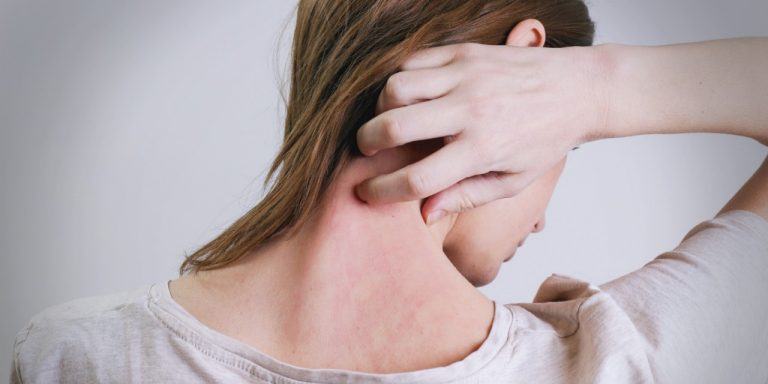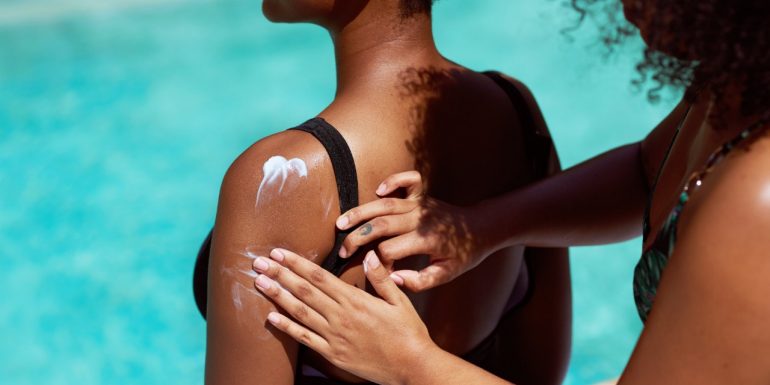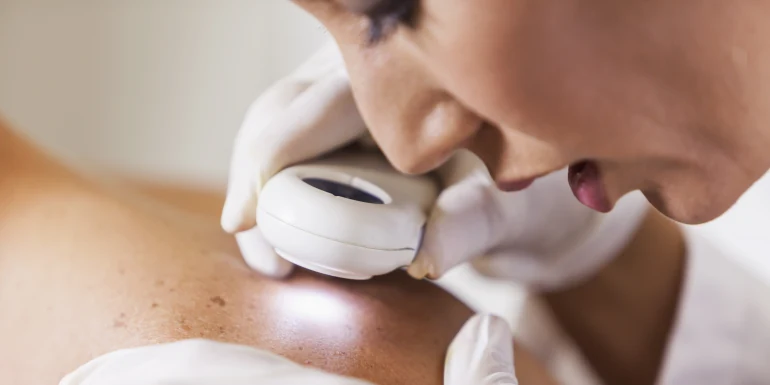
Sun allergies: recognising and treating symptoms
Pimples and an itchy rash instead of sun-tanned skin? Sun allergies cause the skin to react to UV light in the form of a nasty rash. How to prevent sun allergies and how you can treat a sun allergy rash.
A sun allergy can completely put an end to any chance of enjoying sunbathing: sun allergies manifest themselves in nasty red pimples and blisters that cause an itching and burning sensation. Thankfully, good preventative measures, home remedies and medications are available for treating nasty rashes.
What is a sun allergy?
The medical term for a sun allergy is photodermatosis, which is a generic term for different skin conditions that are triggered by a reaction to sunlight. What they have in common is that the body’s natural protective mechanism against UV rays fails, leading to symptoms such as itchy skin, burning, blisters or wheals.
The exact causes and mechanisms of these pathological skin changes have not yet been conclusively researched.
Factors that can trigger sun allergy are:
- UVA and UVB rays
- Fragrances and essential oils
- Natural ingredients, specifically those that contain furanocoumarins like parsley, celery or lime
- Preservatives in creams and lotions
- Emulsifiers in creams and lotions
- Paradoxically, certain UV filters in sunscreens, for example PABA
- Medication, such as anxiolytics, chemotherapeutics, non-steroidal anti-inflammatory drugs, anti-depressives, acne medication, cortisone.
If you take medication, you should seek advice from your doctor before sunbathing.
Whether you are seeking advice on diet and exercise, coping with a diagnosis or a recommended treatment, we will give you expert and individual answers. Our health consultation advisors will provide you with helpful information and practical tips.
Symptoms: what does a sun allergy entail?
The symptoms usually appear hours or days after sun exposure. The skin can react to the sun in different ways. The following skin reactions may indicate a sun allergy:
- A blister is a cavity filled with (clear) fluid.
- A papule is a round to oval nodule on the surface of the skin.
- A plaque develops from papules that have moved together and merged to form a (plate-shaped) plateau.
- Pustules are cavities filled with pus.
- Wheals are an elevation of the skin surrounded by redness that usually itches and burns, such as with stinging nettles.
- Swollen skin in the affected areas
In Switzerland, more than 3,000 people are diagnosed with skin cancer every year. Most skin cancer is caused by ultraviolet rays from exposure to sunlight. Early detection can save lives. Learn more about this illness in our article.
How do you treat a sun allergy?
Avoid direct sun exposure. If you have a mild sun allergy, symptoms such as itching, skin irritation or pimples will go away on their own after a few days – usually without leaving any traces on the skin or permanent damage.
For more severe symptoms, anti-inflammatory ointments, creams and lotions containing cortisone can provide relief. Itching can be cured with antihistamines for sun allergies. These are used to treat solar urticaria in particular. Some of the products mentioned are only available on prescription. Seek advice from a medical specialist.
Children and babies are particularly sensitive to sunlight. So avoid strong sunlight and ensure your child stays in the shade. If you discover a rash, a sun allergy doesn’t necessarily have to be the trigger – children often react to the ingredients in sun cream. Special sun cream for sensitive skin can help prevent these intolerances.
In the event of an acute allergic reaction, take your child out of the sun immediately and cool using classic home remedies. After seeking medical advice, children aged six and above can be treated with a cortisone cream or lotion. If symptoms persist or worsen, consult your doctor or pharmacist. This applies to both children and adults.
Home remedies for sun allergies
Some household remedies have a cooling and healing effect. However, they should only be used to relieve mild skin irritations. If you have open sores or if the blisters have already burst, you should consult a healthcare professional.
Aloe vera
If you apply aloe vera to the affected area, it will soothe the skin and relieve the itching caused by the sun allergy. A cooled gel or the juice directly from the leaf of the aloe vera plant works best. Various aloe vera-based remedies are available without a prescription in chemists. If you use ready-to-use products, look for perfume-free ones.
Healing clay
Healing clay contains minerals, has an anti-inflammatory effect and soothes sun-damaged skin. To relieve the sun allergy symptoms, simply mix the healing clay with cold water to form a spreadable paste and apply to the affected areas. Allow to dry and rinse off with water. Done.
Cardiospermum
Cardiospermum, also called balloon vine, heart seed or heart pea, is referred to as natural cortisone. The plant has an anti-pruritic and anti-inflammatory effect. It can be applied to the skin as an ointment to treat sun allergies.
Cold compress
Apply a cold compress to the affected area. It can relieve the itching and the rash caused by a sun allergy.
How can you prevent sun allergies?
The following sun allergy tips can help prevent annoying symptoms from occurring in the first place – prevention is better than cure.
Prepare your skin for the sun gradually
We sit in the office all year round and then suddenly bake in the sun for hours: no wonder our skin overreacts. If you let your skin acclimatise to increased UV exposure slowly during the holiday and use a good sunscreen, you have a better chance of enjoying your holidays without a sun allergy.
Cover yourself
Wear clothes that cover your skin. Do not forget a sun hat. It’s also advisable to avoid the sun during the hottest time of the day – i.e. between 11 a.m. and 3 p.m. This is when UV rays are their strongest and most dangerous.
What sun cream should you use for a sun allergy?
The right sun cream is key to avoiding a sun allergy. Apply sunscreen before you expose yourself to the sun and reapply regularly. Keep the following in mind:
- Effective sunscreens filter out UVA and UVB rays
- The sun protection factor should be at least 30 to 50
- Ideally, they contain antioxidants that provide additional cell protection and thus increase the protective effect.
Do you have sunburn? Find out what to do in our article.
Avoid cosmetics and perfumes while sunbathing
Perfumes, body sprays or scented body lotions can severely irritate the skin in the sun, trigger itching and cause a sun allergy. It is better to use unscented products during the summer months.
Prevent sun allergies with the right diet
Certain foods also contain sun protection. Fruit and vegetables such as carrots, tomatoes, red berries, watermelon, grapefruit and apricots are rich in beta carotene and lycopene – two vital nutrients that boost skin pigmentation.
Other helpful foods include oily fish such as salmon, tuna and sardines, chia seeds and flaxseed, and vegetable oil such as linseed oil, camelina and rapeseed oil. These foods are rich in omega-3 fatty acids and have antioxidant properties. They can reduce susceptibility to UVB-induced skin redness.
Combat sun allergies with calcium
Calcium can prevent the release of histamine in the event of an allergic reaction. This makes it a key nutrient in preventing sun allergies. Calcium is contained primarily in dairy products (cow’s milk, yoghurt, cheese) and green vegetables like leaf spinach and broccoli. Remember: medical advice is to start taking calcium supplements about two weeks prior to a holiday or sunbathing.
A summer without sun allergies? With the right preparation and the right preventative measures, nothing should prevent you from sunbathing. We mustn’t forget that we need the sun so our skin can generate vitamin D – vitamin D is important for healthy bones. And if your skin does show the typical signs of a sun allergy, home remedies can help to alleviate annoying rashes.

The expert provided the editorial team with advice and input for this article. Ilenia Battistella (pharmacist) works for the Helsana health consultation service. She helps customers on issues to do with prevention and health promotion.


Newsletter
Find out more about current health issues every month and get all the information you need about our attractive offers from all Helsana Group companies * delivered by e-mail to read whenever it suits you. Our newsletter is free of charge and you can sign up here:
We did not receive your information. Please try again later.
* The Helsana Group comprises Helsana Insurance Company Ltd, Helsana Supplementary Insurances Ltd and Helsana Accidents Ltd.